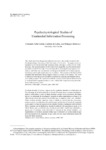Psychophysiological studies of unattended information processing

Use this link to cite
http://hdl.handle.net/2183/29509Collections
- Investigación (FEP) [513]
Metadata
Show full item recordTitle
Psychophysiological studies of unattended information processingDate
2000-05Citation
Valle-Inclán F, de Labra C, Redondo M. Psychophysiological studies of unattended information processing. Span J Psychol. 2000;3(1):76-85
Abstract
[Abstract] The article describes the general methods and some of the results obtained in the Psychophysiology Laboratory of the University of La Coruña. The paper covers our research on the Simon effect and accessory effect, although it is not a review of the literature. The research strategy we followed is built around the use of lateralized motor potentials recorded from scalp. These measures allow observing the way responses are selected and when they are selected, providing an invaluable tool to study response interference and to split reaction time into two halves. The research on the Simon effect concludes that interference during response selection is critical in the Simon effect but it is dubious whether this process should be considered as automatic and stimulus-driven, as is widely accepted. The experiments with the accessory effect indicate that facilitation is produced before response selection is over, which ends a long controversy about the locus of the accessory effect. [Resumen] El artículo describe el método y algunos de los resultados obtenidos en el laboratorio de Psicofisiología de la Universidad de La Coruña. El trabajo abarca nuestra investigación sobre el efecto Simon y sobre el efecto accesorio, aunque no es una revisión del corpus teórico. La estrategia de investigación seguida en estos experimentos se basa en la utilización de potenciales motores lateralizados que se registran sobre cuero cabelludo. Estas medidas permiten observar cómo y cuándo se seleccionan las respuestas, proporcionando una valiosísima herramienta para estudiar la interferencia de respuesta y para partir el tiempo de reacción en dos mitades. Nuestra investigación sobre el efecto Simon concluye que la interferencia durante la selección de respuesta es crucial en el efecto Simon, pero no está tan claro si este proceso debe considerarse automático y guiado por el estímulo, como defienden la mayoría de las teorías actuales. Los experimentos con el efecto accesorio indican que la facilitación se produce antes de que termine la selección de respuesta, lo que acaba con una larga controversia acerca del locus del efecto accesorio.
Keywords
Simon effect
Accesory effect
ERP
LRP
Efecto Simon
Efecto accesorio
Accesory effect
ERP
LRP
Efecto Simon
Efecto accesorio
Editor version
ISSN
1138-7416





